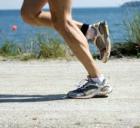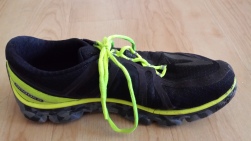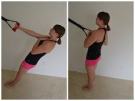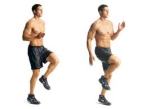By: Geoff Rubin, Fitness Propelled, CPT/CIFT/TRX II
I certainly think they do. Running surface differences are quite vast, from grass fields, to synthetic tracks, to the brutality of pavement. The beauty behind all of these surfaces is that the majority of them are easily accessible to us, almost anywhere in the world. However, we know that all surfaces have their own pros and cons as related the health of our feet and on up from there. I am sure that you would agree that the softer the surfaces you run on the longer your running career will last. That is why I wanted to examine my top 5 running surfaces, and what are our feet and bodies were saying to us after.
Ratings are listed as most preferred to least preferred.
1. Grass – Ahh grass, the finely cut blades of an open field, with a soft layering of compact dirt beneath. This is my clear cut preferred surface for running on. Grass also provides with the options of running barefoot, connecting with our running surfaces and making sure that we connect every step with the surface it is hitting.
Pros: Grass is soft and easy on the legs in terms of impact, but makes your muscles work hard as the surfaces vary. This builds strength and help drive improvement when returning to the road. Additionally when you find an open field, your surrounded by others who utilize the grassy area for their own recreation providing constant sources of people gazing.
Cons: Grassy plots are often uneven and can be dangerous for runners with unstable ankles. It can also be slippery when wet, runners with allergies may suffer more symptoms when running on it, and its softness can tire legs rather quickly.
2. Sand – If only more of it were available in Arizona. Sand offers a run with a challenge. When the sand is dry and deep, you give your calf muscles an excellent work-out without risking any impact damage to your joints.
Pros: Sand gives an opportunity to run barefoot in a pleasant environment. Running through dunes provides good resistance training and strengthens the legs. Open air with vast distances and crashing waves isn’t a bad place to settle into a constant running stride.
Cons: The pliability of sand means a higher risk of Achilles tendon injury. Also, when you run on the sand at the water’s edge, the tilt of the surface puts uneven stresses on the body.
3. Synthetic Track – Who doesn’t love a track that is made up of synthetic material, laid out and measured in 400 meter distances. These tracks are generally open to the public, allow runners to measure distances accurately, and focus on improving times related to desired distances.
Pros: Synthetic tracks provide reasonably forgiving surfaces and are pretty close to being 400 meters around, make measuring distances and timing sessions easy.
Cons: With two long curves on every lap, ankles, knees and hips are put under more stress than what one might be accustom to. Longer runs also become rather boring. Rat cage anyone?
4. Treadmill – The constant option. Treadmills are the best indoor running option for most runners. Generally, treadmills have monitors that display incline, pace, heart rate, calories burned and other data, which give us users with constant feedback. The running surfaces vary depending on make and model of treadmills.
Pros: The smooth, constant surface is generally easy on the legs, and hitting a desired pace is as easy as setting a number. Additionally, you don’t have to worry about X-factors such as animals, wind and bad weather. The constant speed and control makes a treadmill ideal for speed work.
Cons: Running on the same spot isn’t very exciting, and if you don’t concentrate on keeping up your pace, you could be thrown off the machine. Treadmill runners tend to sweat profusely as your usually cooped amongst other runners with limited air flow. Machines are too expensive for most runners, and gym memberships may be unrealistic if you are just going there to run.
5. Roads – Just look outside your front door and take that first step. Altough very abundant, it certainly isn’t exciting to run on something meant for commuter traffic. Concrete is primarily made up of cement (crushed rock), and it’s what most pavements and five per cent of roads are constructed from. It delivers the most shock of any surface to a runner’s legs.
Pros: Concrete surfaces tend to be easily accessible and very flat. They go on forever, and accruing mileage won’t be a hard task.
Cons: The combination of a hard surface and the need to sidestep pedestrians, can lead to injury and too much weaving.
These are my top 5, please leave your comments below and share your running surface preference below or some funny stories that have occurred to you while running on one of your favorite surfaces.
Website: http://www.fitnesspropelled.com
Follow us on Twitter @ FPropelled – https://twitter.com/FPropelled
Like us on Facebook @ https://www.facebook.com/FitnessPropelled
Pin and follow us @ http://www.pinterest.com/FitNsPropelled/
Youtube: https://www.youtube.com/channel/UCUeuNEGlf9yilJ6Yd-pI5XQ/feed
View us on Yelp @ www.yelp.com/biz/fitness-propelled-llc-scottsdale
Sources:
– Top 10 running surfaces – Marc Bloom and Steve Smythe
– Google Images
















 How to do it: Secure a cable or resistance band at waist height on your right side. Stand with your feet hip-width apart, knees slightly bent, and hold the cable in front of you with straight arms—there should be tension in the cable. Brace your core. Maintaining an erect torso and without moving your legs, rotate your torso so that your hands (and the cable) move to the left while maintaining your original head position. Rotate back to the start and all the way to the right. Switch positions so the cable is on your left side, and repeat.
How to do it: Secure a cable or resistance band at waist height on your right side. Stand with your feet hip-width apart, knees slightly bent, and hold the cable in front of you with straight arms—there should be tension in the cable. Brace your core. Maintaining an erect torso and without moving your legs, rotate your torso so that your hands (and the cable) move to the left while maintaining your original head position. Rotate back to the start and all the way to the right. Switch positions so the cable is on your left side, and repeat.